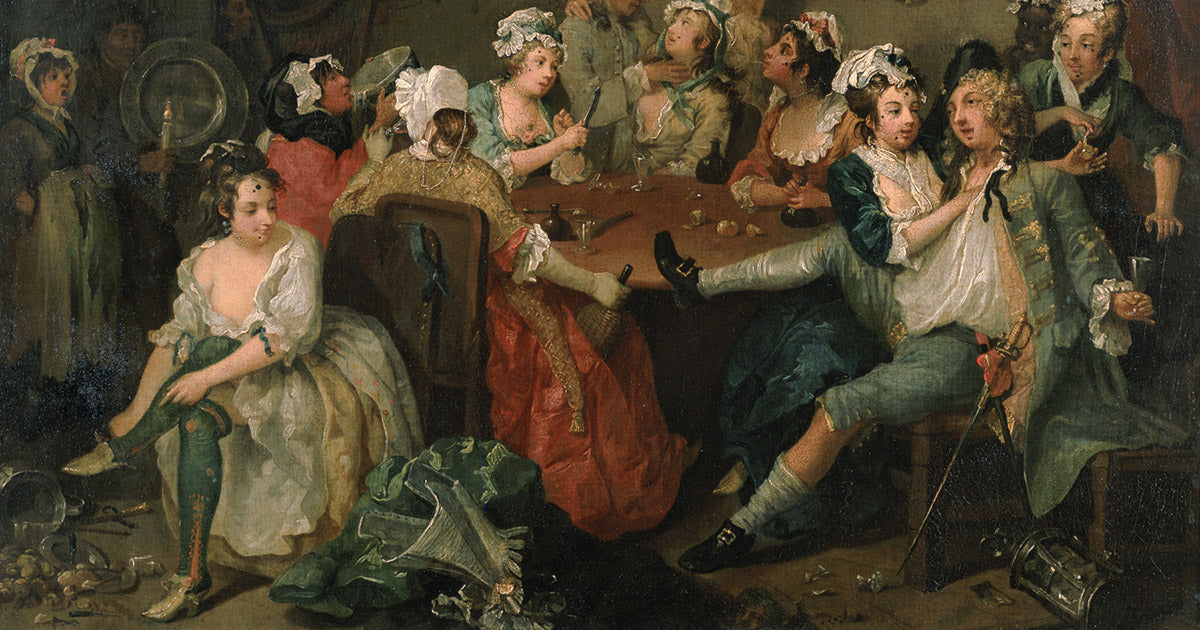
Pictured above: This 18th-century painting shows a man and a woman wearing decorative socks in a crowded tavern. The woman pulls up her over-the-knee socks and eyes the man's socks, one of which has slipped down his leg.
Did you ever wonder when people started wearing socks, and how we got the many types of socks we wear today? We found all sorts of fun facts about socks when looking into their origins and their evolution. This history of socks timeline should help you learn a little more about how we went from the earliest socks made of grass to the functional and fun socks we know and love today.

A replica of the shoes found with Ötzi, a mummified man who likely lived between 3350 and 3105 BC. The leather shoes were lined with a netting made of bark filled with soft hay — could this lining have been the first "socks"?
The Origin of Socks
3,400 B.C. — In 1991 archaeologists find a Neolithic mummy in the Alps who was given the nickname Ötzi. Along with other well-preserved clothing, Ötzi wore a pair of shoes made from the skin of bears and deer. Inside the shoes was perhaps the very first known example of ancient socks: a netting of bark lined with soft hay. This shoe lining would have kept his feet warm while wicking away moisture, two important uses of socks today!
Who invented socks?
While nobody knows exactly who invented socks, many ancient cultures around the world had some version of a sock, often a piece of cloth made to be wrapped around the feet inside of shoes.
600 B.C. — Felted fur socks. The Ancient Greeks wear a style of socks called “piloi,” which were made from matted animal fur, probably similar to felt. In fact, the Greek word for felt was “pilos,” the singular form of piloi. To the Greeks, the purpose of socks was purely functional: keeping one's feet warm and lining leather shoes to make them more comfortable.
In 500 BCE, Greek poet Hesoid wrote in his poem Works and Days,“around your feet, tie your sandals made from brutally hunted oxen skin and, under these, dress them in piloi."
300 A.D. — Egyptian socks. A method of making socks called nålebinding is used to make socks and other fabrics. Similar to knitting but more time consuming, this method was used to make a pair of bright red socks discovered in a burial ground on the Nile and currently displayed the Victoria and Albert Museum in London. They may not be just like the crazy socks we have today, but at least they are a bright and bold color!
What did people wear before socks?
Before socks, many cultures wrapped their feet in cloth. That is because before knowledge of knitting became widespread, weaving was the primary way people turned spun fibers into fabric.
400 A.D. — In Europe at this time, a type of foot wrap called a puttee is worn by holy people as a way to symbolize their purity. Back then, someone who never had to get their feet dirty would have been seen as very special indeed. Puttees were put on by spiraling a long, thin piece of cloth around the lower leg and continued to be worn by indigenous tribes and in uniforms like those of the British Army clear up to World War II.

November 6, 1918 — A photo from World War I shows American soldiers in puttee leg wraps greeting an elderly French couple in the Ardennes, France.
When did fun socks become popular?
While socks were invented for practical reasons, people started to really have fun with their socks by around 1,000 A.D. when wearing colorful stockings, socks and leggings became a symbol of luxury.

1590 — In this oil painting, George Clifford, 3rd Earl of Cumberland shows off his unique hosiery, a pair of stockings decorated in gold stars. Clifford was a courtier of Queen Elizabeth I.
1000–1500 A.D. — During the Middle Ages, wealthy Europeans begin wearing long, colorful knee socks to show off to the other nobility. Some people even wore mismatched stockings with each leg a different color! These socks and stockings were made by sewing together pieces of fabric like silk, wool and cotton. They weren't very stretchy and would fall down without a sock garter.
1200 — Knitting arrives in Europe, with the first knitted items being made by Muslim knitters employed by the Spanish royal families. From there, the practice likely spread quickly, becoming popular enough by the 14th century that some painters even depicted the Virgin Mary knitting.
Who invented socks and sandals?
We are not sure who invented socks and sandals, one of the most controversial footwear fashions of our time. However, we know that ancient Romans were wearing socks with sandals 2,000 years ago, and the style has emerged in different cultures around the world ever since.
1400s A.D. — Japanese people began wearing tabi socks, a style of sock with a split in the middle. Tabi socks were designed to be worn with thonged sandals like wooden geta clogs or zori sandals, which are similar to our modern flip-flops! Traditional tabi socks were white, but today your can find all kinds of fun, colorful novelty socks with split toes.
Why are socks white?
The color white is associated with purity and cleanliness. By wearing white socks, people can quickly see that your feet are clean (especially if you wear them with sandals). This subtly signals that you are healthy, hygienic and can afford plenty of new socks when the old ones get dirty!

A drawing of William Lee's knitting machine, invented in 1589 to quickly knit stockings.
1589 A.D. — The first stocking frame knitting machine is invented by William Lee in England. Concerned that the machine would take jobs away from her subjects, Queen Elizabeth I refused to give Lee a patent, so he took his invention to France. Eventually the machines became widespread, but they were only able to make a flat piece of stocking fabric that still needed to be hand-sewn up the back, creating a seam.
1801 — Punched cards with patterns (similar to the Jacquard cards used in weaving since their invention in the 1700s) allowed people to program knitting machines to create intricate designs that would come out the same every time. These cards were the forerunners of the punchcards used to create the first computer programs.

A modern example of a circular knitting machine at work at a Darn Tough sock factory in Northfield, Vt.
1816 A.D. — French engineer Marc Brunel builds the first circular knitting machine. By arranging the needles in a circle rather than a flat bed, he made it possible to turn out the tube of a sock instead of a flat piece of fabric. British sockmaker Matthew Leo Townsend would perfect this design with a new type of needle called a latch needle in 1857, which became all the rage in America when Townsend immigrated to New England. As knitting machine factories made knitted items cheaper and easier to produce, hand-knitting grew less common in the industry, but remained a popular hobby.

October 8, 1923 — A group of women wearing their stockings rolled down below their knees surround a man playing the piano.
1920s — Flappers make socks a sex symbol. In the 1920s it was unheard of for a woman to leave the house with her legs uncovered. Silk stockings were worn to make sure nobody could see the skin on your legs (and were also great for covering up leg hair). The trendy flappers began wearing their stockings rolled down below the knees to show off a little skin! They would often put red makeup on their kneecaps to make them look cute and rosy.
How did socks stay up before elastic was invented?
Before we had elastic socks, socks and stockings were held up with garter belts or sock garters. They weren't always the most comfortable contraptions, and these days they are usually just worn for looks, not necessity.

July 26, 1941 — A U.S. Department of Agriculture fabric technician inspects cotton stockings, a product that served as a wartime substitute for silk stockings and the newest fad, nylon stockings, which were not being produced fast enough to meet demand. A caption explains that with the silk supply waning, "the ladies will probably be wearing cotton stockings by the end of the year or else go barelegged."
1938 — The first elastic socks. Nylon is invented during World War II as a substitute for silk, which had become difficult to come by after supply from Japan, the leading silk exporter, was cut off. Soon this "wonder fabric" is used as elastic in socks and to make the first nylon stockings, which become a worldwide fad. Nylon continues to be used today to give many of our crazy socks their stretch!
1950s — Dancing in your socks. As teenage culture rose to the forefront of society, teen trends like the sock hop became popular across America. These social dances were usually held in high school gyms, where young people would gather wearing socks without shoes and dance to the latest craze in music: rock and roll. White bobby socks folded down to create a cuff at the ankle were by far the most popular style.
1960s — In the 1960s, socks and tights for women blossomed into bright colors and crazy patterns. It became common to match your dress to your socks. People wore chunky socks in the winter to keep warm and add a fashion statement, too. For men, plain white sports socks became the modern fashion, similar to the typical crew socks still worn today.
1980s — The popularity of novelty socks grew during the eighties, with slouchy socks and leg warmers becoming must-haves for dancers and fitness fanatics. Ruffled and lace-topped ankle socks, originally popular in the '40s and '50s, came back in style and were worn by celebrities like Madonna and Cyndi Lauper.
1990s — Novelty socks became a part of every millenial's back-to-school shopping list. Most popular were fun patterns, bright colors and of course knee socks — and nobody looked better wearing them than the fashionable character Cher in the movie Clueless, which came out in 1995.
These days, fun socks are wilder and more imaginative than ever!
2011— Our business opened and began selling novelty socks in Bellingham, Washington.
With more than 10 years in the business, we know socks inside and out! Our inventory has continued to expand and our fan base has grown, making our store a top destination for downtown Bellingham gift shopping. Step through our doors and enter a sock paradise full of colorful displays and unique socks that help you express yourself to the world.
The Best Place to Buy Socks Online
At Cute But Crazy Socks, we are the sock experts. We have the best selection of crazy socks online with every pattern you can imagine and popular brands including Blue Q, Sock It to Me, Socksmith, Solmate Socks, Gumball Poodle, Darn Tough and of course our in-house brand, ModSocks.
This image shows me wearing a pair of ModSocks' original Mushrooms knee-high socks while standing next to a fungus-covered stump in Bellingham, Wash.
The ModSocks brand uses cutting-edge sock technology to manufacture beautiful, detailed images on socks. ModSocks has even pioneered a few techniques to make socks stretch better around the calves without sacrificing cute design!
Cute But Crazy Socks gives back by donating 1% of all product sales to support mental health.
Explore what we have to offer and marvel at how far the simple sock has come when you visit our website. Comment below with what kinds of socks you would love to see us carry, and help us shape the future of socks!
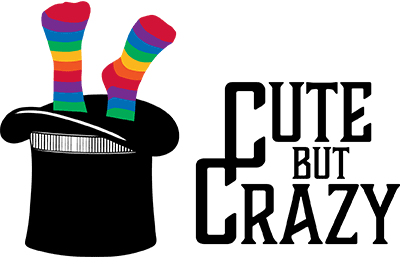
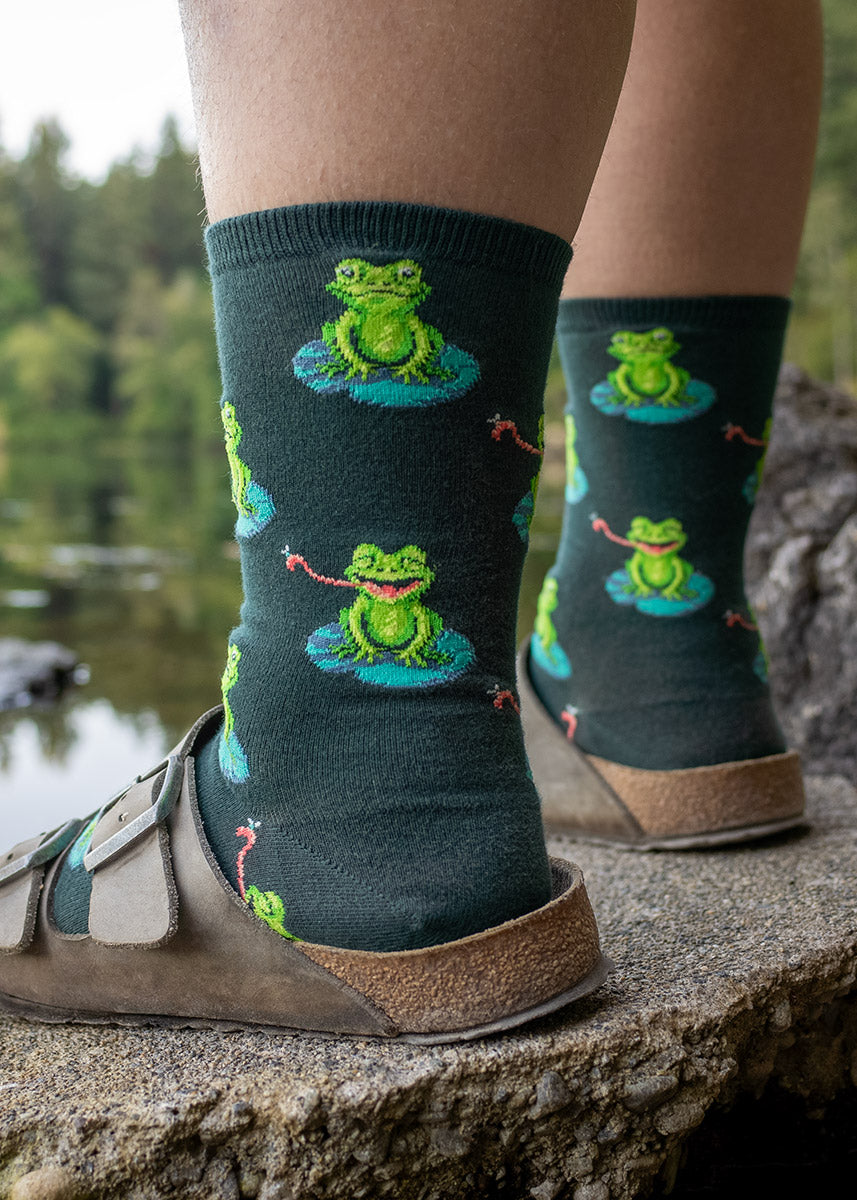
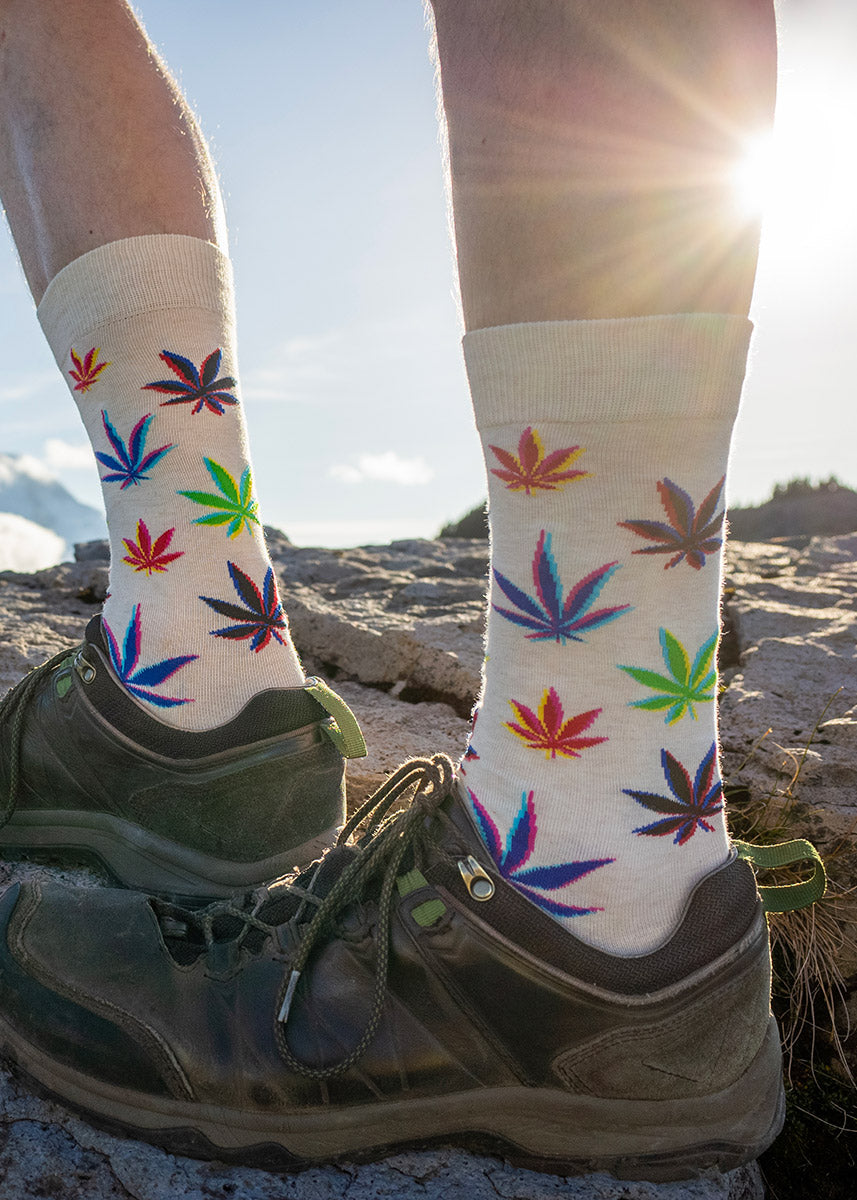


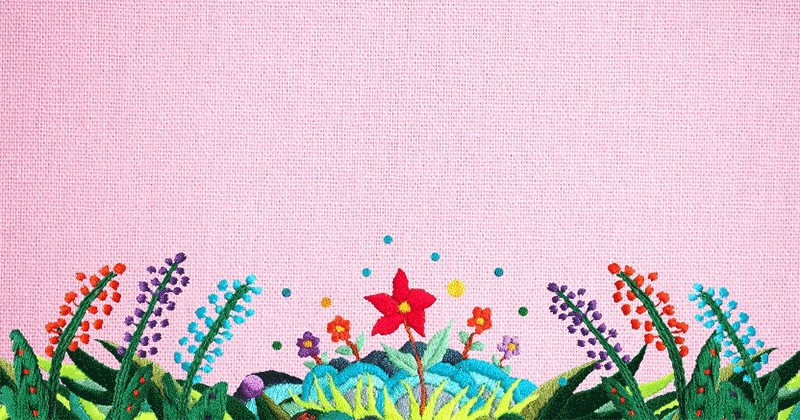
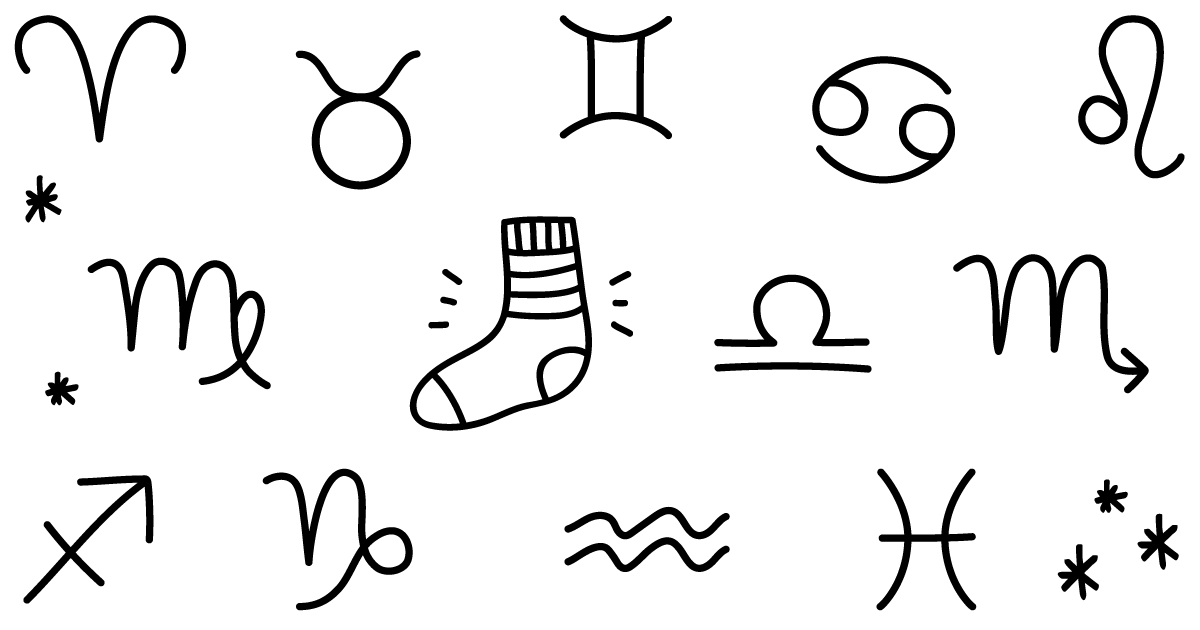
rj
November 14, 2022
love those mushroom socks!